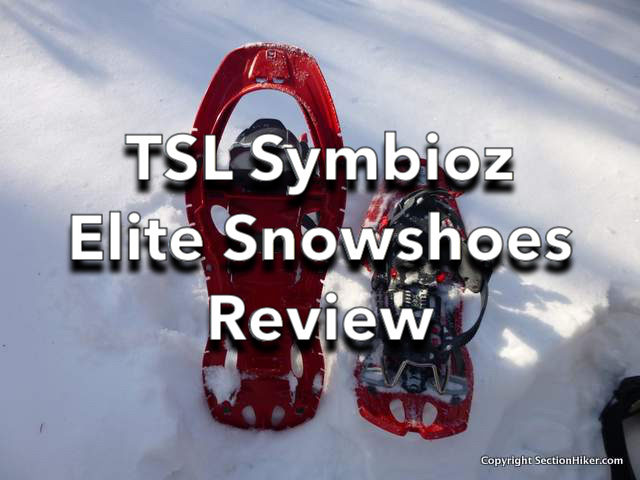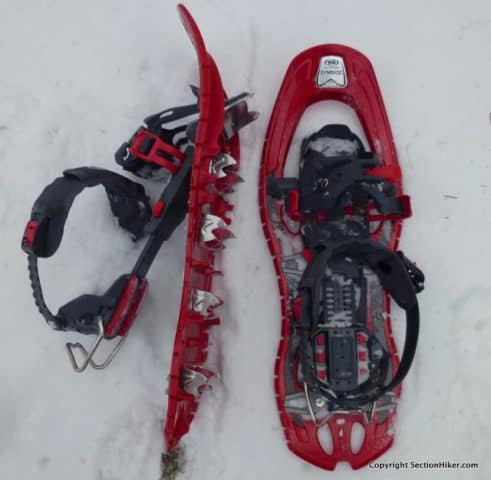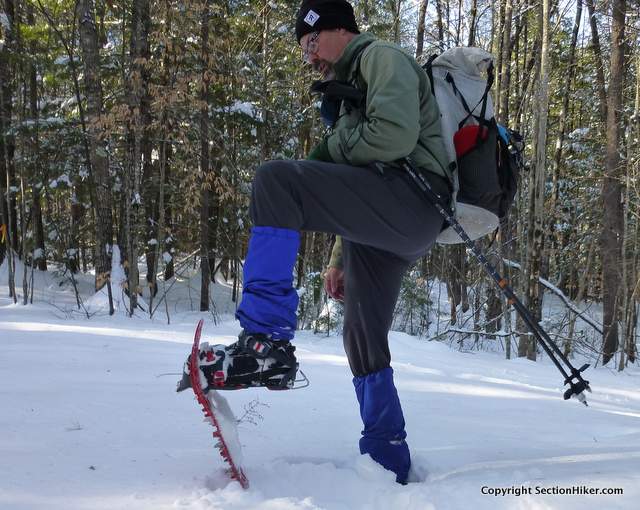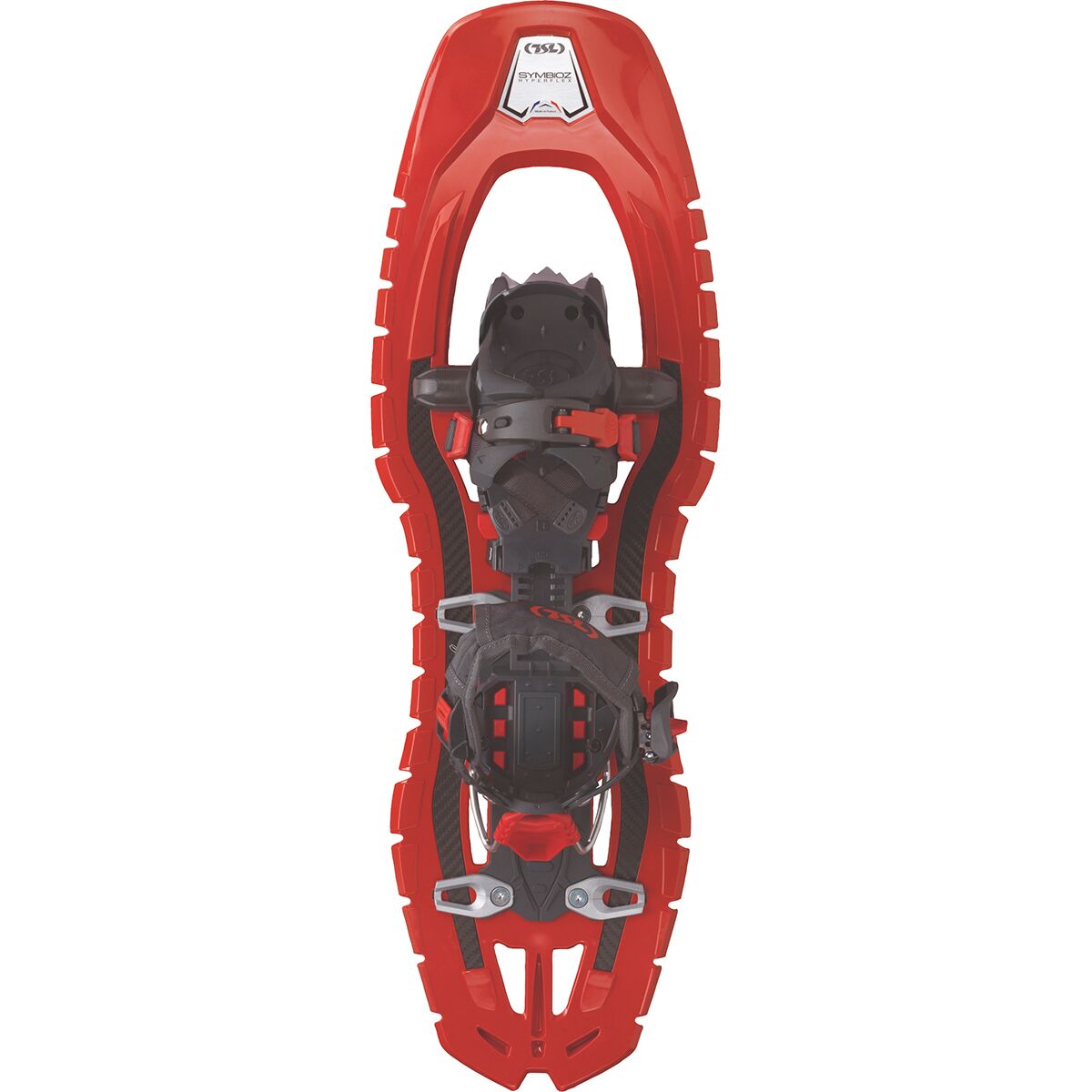
TSL’s Symbioz Elite Snowshoes are designed for use in mountainous terrain with aggressive crampons and a heel lift for climbing steep and icy slopes. They have a large horizontal front crampon, good for digging into slopes, with 8 stainless-steel cleats (rotated 90 degrees) down the sides to prevent side slipping.
But what sets these snowshoes apart from all others is the comfort and ergonomics of snowshoeing in them. It doesn’t matter if you’re snowshoeing along a packed trail or breaking trail in deep powder, it feels like you’re walking in a normal pair of shoes when you wear them, not bowlegged, or pronated, or duck-footed, the way that many other snowshoes make you feel. Snowshoeing with them is simply easier, resulting in less fatigue and greater comfort. Much greater comfort.

TSL Snowshoes Symbioz Elite Snowshoes
Weight
Durability
Binding
Traction
Flotation
Comfort
Specs at a Glance
- Sizes (L, M, S)
- Dimensions: 27 x 8.5″ / 23.5 x 8″ / 20.5 x 7.5″
- Weight: 4 lbs. 12.8 oz. / 4 lbs. 4.8 oz. / 4 lbs. 1.6 oz.
- Rec. Max Load : 150 – 300 / 110 – 260 / 65 – 180
There are several factors that make these snowshoes unique.
First is the hourglass shape, wider in the front and narrower at the rear, which keeps you from stepping on your opposite snowshoe as you walk. Slots in the decking help keep snow from accumulating on top, while the short length helps keep your gait normal. The shorter length of these snowshoes means that they have less flotation than much larger ones, something to consider if you’re looking for a less technical snowshoe designed for flatter terrain and deep powder.
Next is the adjustable binding system which can be set both length-wise and across your toes to precisely fit your boots. The binding “remembers” your settings, so you can just slip your boots into them without having to re-adjust the binding every time you use the snowshoes. Simply flip the plastic hinge above your toes to lock your forefoot in place and ratchet close the padded strap that reaches around the front of your ankle. Once set up, it’s as simple as slipping on a pair of loafers. Fast transition times are important in winter because you need to keep moving to stay warm. The last thing your hiking partners want to do is watch you fight with a snowshoe binding.

The nice thing about the Symbioz Elite binding system is that you don’t have to make the toe or the ankle binding super tight when you strap yourself in. Both the toe and heel bindings lock your boot in without the need for a lot of pressure from the straps. This eliminates rubbing and hotspots inside your boots while maintaining good blood flow, which will keep your toes and feet warmer.
The Symbioz Elite is like a lot of other mountaineering style snowshoes in that is has a heel lift, which can be deployed when you’re climbing up a hill. The function of the lift is to raise your heel, so it feels like you’re walking on level ground even though you’re hiking up an incline. This greatly reduces calf fatigue, so you can keep hiking longer. Rather than flip the lift up under your heel like MSR snowshoes, you push it down with Symbioz Elite, a process which is trivial to do with the handle or basket of your trekking pole. It’s equally easy to flip it up, again with your trekking pole handle.
Finally, there’s the Hyperflex frame, made with a springy plastic decking and carbon fiber strips, which allows the snowshoe to flex around ground features, keeping the crampons and cleats in the snow while reducing slippage. The flex also helps reduce the amount of balling (clumping of snow) that occurs on the bottom of the snowshoes when you get them wet or in warm conditions.

If there’s one gotcha with the Symbioz Elite, it’s the bulk of the binding which prevents stacking the snowshoes and lashing them to the back of your pack, the way you can with a lay-flat ski-strap-style binding. This means you need a backpack with sufficiently long side compression straps, so you can lash the Symbioz Elites to the sides of the pack when you have to carry them.
Comparable Winter Hiking Snowshoes
| Make / Model | Heel Bar | Binding |
|---|---|---|
| MSR Lightning Ascent | Yes | Mesh Net |
| MSR Evo Ascent | Yes | TriFit Straps |
| Tubbs Flex VRT | Yes | Boa |
| Tubbs Flex ALP | Yes | Ratchet Strap |
| TSL Symbioz Elite | Yes | Ratchet Strap |
| Tubbs Mountaineers | Yes | Ratchet Strap |
| Atlas Range BC | Yes | Webbing Strap |
| MSR Revo Explore | Yes | Ratchet Strap |
| Northern Lites Backcountry | No | Ski Straps |
| Crescent Moon Backcountry 32 | Yes | Webbing Strap |
Recommendation
The TSL Snowshoes’ Symbioz Elite Snowshoes are optimized for use in steep technical terrain with aggressive crampons and a comfortable binding system that can be preset to match your precise boot size. But what makes these snowshoes unique is the comfort and ergonomics of using them. They facilitate a very natural stride that feels a lot more like hiking than snowshoeing, helping to conserve your energy across a wide range of snow conditions.
Disclosure: The author purchased this product with his own funds.
Compare 2 Prices
-

 Backcountry.com$289.95View
Backcountry.com$289.95View -

 Amazon US$330.49View
Amazon US$330.49ViewAmazon.com Price: $330.49 (as of 04/26/2024 20:31 GMT-0400) Details
Product prices and availability are accurate as of the date/time indicated and are subject to change. Any price and availability information displayed on Amazon.com at the time of purchase will apply to the purchase of this product.
 SectionHiker.com Backpacking Gear Reviews and FAQs
SectionHiker.com Backpacking Gear Reviews and FAQs
We have been very happy with our sturdy, lightweight MSR snowshoes for many years but all our friends have switched over to boa type bindings… as we freeze our hands trying to get our snowshoes on or off they accomplish the task in a fraction of the time. I have my eye on the TSL symbioz hyper flex but the Elite wasn’t on my short list. Are there particular features of the Elite that I should consider? I was under the impression that it is a racing snowshoe. I like the adjustable option as my mid-winter boots are bulkier and larger than my spring snowshoe boots. Any input much appreciated.
The elite is not a racing snowshoe. It’s what most serious hikers who use TSL snowshoes use in the White Mountains. I’ve never used the hyperflex and don’t know anyone who has. The Elite is not great for flotation, but it is superb for traction with really aggressive cleats.
I’ve used it. It’s fine. Yes, that would be a good size.
Phillip,
I have read about these snowshoes and thought they would be a good choice. I have taken your previous advice and have the latest pair of MSR Lightening ascent. I like the mesh addition, but you really sound like these are your new favorite go to snowshoes because of the ease of the binding, traction and natural gait. Do you find these outperform the MSR? I would be using in the Whites. I guess I’m going to have to purchase a pair.
Thanks
Tom
Funny you should ask. I’ve been wearing these snowshoes for the past month or so in a variety of conditions. They are super for climbing mountains in icy conditions but the flotation is pretty lackluster in deep powder. The cleats underneath are insanely aggressive, but very uncomfortable when worn on mixed rock, snow, and ice which is pretty typical above treeline. I also find them less stable than MSRs (any model) and more prone to titling from side to side. The bindings are much more comfortable than the classic 3 strap MSR pending (pre-paragon) and stay reliably closed, they put a lot of pressure on the tops of my toes, which for me is painful due to the metatarsalgia (ball of foot pain) which I started suffering from last year. Anyway, I plan to switch back to the Lightning Ascents with the mesh binding which I find more stable and less painful to use. I have friends who swear by the TSLs, but I really do prefer more flotation. I’m gridding these days, so I’m climbing a lot of peaks each month and its been useful for re-evaluating my snowshoes. I would try them – you can always return them via REI and selling them used should be easy.
Phillip,
Thank you for the insight and detailed reply. I appreciate the information and your feedback. Good luck with the gridding.
Thanks
Tom